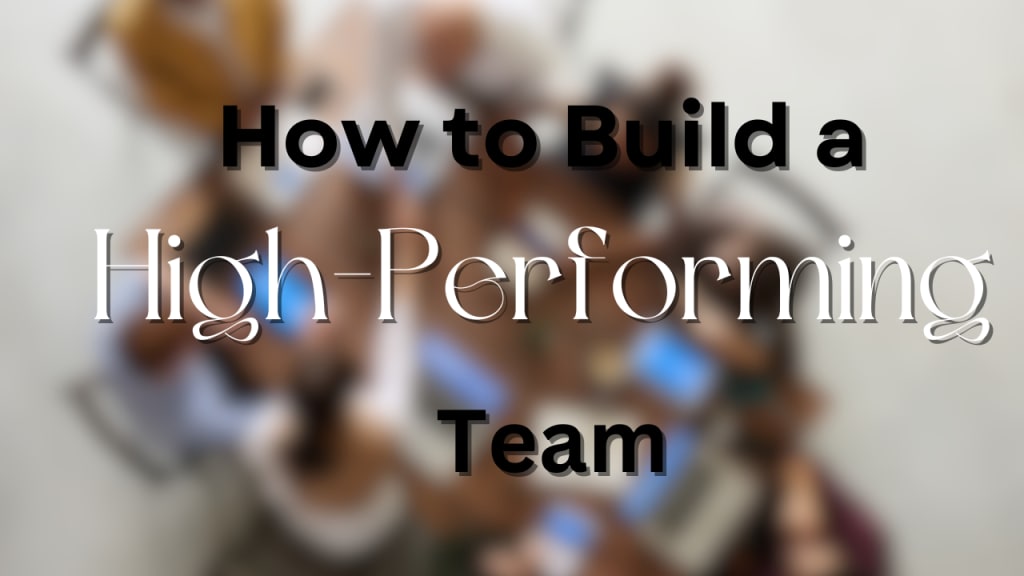How to Build a High-Performing Team
Strategies for Cultivating Collaboration, Communication, and Excellence

Building a high-performing team is essential for the success of any organization. A cohesive and motivated team can achieve remarkable results, overcome challenges, and drive innovation. In this comprehensive guide, we'll explore proven strategies and best practices for assembling, nurturing, and leading a high-performing team.
Click Here to Discover High-Demand Products for Your Store!
1. Understanding the Importance of High-Performing Teams
The Power of Collaboration
High-performing teams leverage the diverse skills, experiences, and perspectives of their members to achieve collective goals.
Key Benefits of High-Performing Teams
Increased Productivity: Teams work together seamlessly, maximizing efficiency and output.
Innovation and Creativity: Collaboration fosters innovation and encourages creative problem-solving.
Employee Engagement: Engaged team members are more motivated, satisfied, and committed to their work.
Adaptability and Resilience: High-performing teams can adapt quickly to change and overcome obstacles.
2. Building the Foundation for Success
Clarify Team Goals and Expectations
Ensure everyone understands the team's objectives, roles, responsibilities, and expectations from the outset.
Establish a Strong Team Culture
Cultivate a positive and inclusive team culture based on trust, respect, transparency, and open communication.
Define Team Values and Norms
Identify and articulate core values and behavioral norms that guide team interactions and decision-making.
3. Selecting the Right Team Members
Identify Key Competencies and Skills
Define the specific skills, competencies, and qualities needed for each role within the team.
Assess Cultural Fit
Evaluate candidates not only based on their qualifications but also their alignment with the team's values and culture.
Promote Diversity and Inclusion
Foster diversity in your team by recruiting individuals from different backgrounds, experiences, and perspectives.
4. Fostering Collaboration and Communication
Encourage Open Communication
Create an environment where team members feel comfortable sharing ideas, feedback, and concerns openly.
Facilitate Effective Meetings
Hold regular team meetings to discuss progress, address challenges, and align on priorities. Keep meetings focused and productive.
Utilize Collaboration Tools and Technologies
Leverage technology platforms and tools to facilitate communication, document sharing, and project collaboration.
5. Empowering and Motivating Team Members
Provide Autonomy and Decision-Making Authority
Empower team members to take ownership of their work and make decisions within their areas of responsibility.
Recognize and Reward Achievements
Acknowledge and celebrate individual and team accomplishments to boost morale and motivation.
Offer Professional Development Opportunities
Support the continuous growth and development of team members through training, mentorship, and career advancement opportunities.
Click Here to Discover High-Demand Products for Your Store!
6. Building Trust and Psychological Safety
Foster Trust
Build trust within the team by demonstrating integrity, reliability, and accountability in your actions and decisions.
Create Psychological Safety
Encourage an environment where team members feel safe to take risks, make mistakes, and express themselves without fear of judgment or reprisal.
Address Conflict Constructively
Acknowledge and address conflicts or disagreements promptly and constructively, focusing on finding mutually beneficial solutions.
7. Leading by Example
Lead with Purpose and Vision
Articulate a clear vision for the team and inspire others with your passion, commitment, and vision for success.
Demonstrate Accountability
Hold yourself accountable for your actions and decisions, setting a positive example for others to follow.
Practice Active Listening and Empathy
Listen actively to the concerns and perspectives of team members and demonstrate empathy in your interactions.
8. Continuous Improvement and Feedback
Encourage Feedback
Create opportunities for feedback and dialogue, soliciting input from team members on how to improve processes and collaboration.
Embrace a Growth Mindset
Cultivate a culture of continuous learning, adaptation, and improvement, where failure is seen as an opportunity for growth.
Regularly Evaluate Team Performance
Assess team performance regularly, identifying strengths, areas for improvement, and opportunities for development.
9. Navigating Challenges and Adversity
Stay Resilient
Equip your team with the tools, resources, and support needed to navigate challenges and setbacks effectively.
Leverage Team Diversity
Harness the diverse perspectives and experiences within your team to find creative solutions to complex problems.
Seek Opportunities for Learning and Growth
View challenges as opportunities for learning and growth, fostering resilience and adaptability within the team.
10. Celebrating Success and Milestones
Acknowledge Achievements
Take time to celebrate milestones, achievements, and successes, recognizing the contributions of individual team members and the collective effort of the team.
Reflect and Learn
Reflect on successes and failures alike, extracting lessons learned and insights that can inform future endeavors.
Maintain Momentum
Use celebrations as an opportunity to reenergize the team and maintain momentum toward future goals and objectives.
Conclusion: Cultivating Excellence Through Effective Teamwork
Building a high-performing team is a journey that requires dedication, commitment, and ongoing effort. By focusing on clarity of goals, strong communication, collaboration, empowerment, trust, continuous improvement, and resilience, you can create a team that excels in achieving its objectives and making a meaningful impact.
Click Here to Discover High-Demand Products for Your Store!
Key Takeaways:
Set Clear Goals: Establish clear objectives and expectations for the team.
Build Trust and Communication: Foster open communication and create an environment of trust and psychological safety.
Empower and Motivate: Empower team members, recognize achievements, and provide opportunities for growth.
Lead by Example: Lead with purpose, integrity, and empathy, setting a positive example for your team.
Embrace Continuous Improvement: Encourage feedback, learning, and adaptation to drive continuous improvement.
Celebrate Success: Acknowledge and celebrate achievements to maintain morale and motivation.
By implementing these strategies and fostering a culture of collaboration, communication, and excellence, you can build a high-performing team that drives your organization's success and achieves extraordinary results.
About the Creator
Enjoyed the story? Support the Creator.
Subscribe for free to receive all their stories in your feed. You could also pledge your support or give them a one-off tip, letting them know you appreciate their work.






Comments
There are no comments for this story
Be the first to respond and start the conversation.